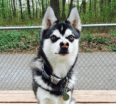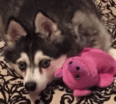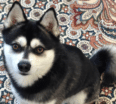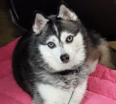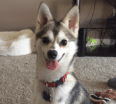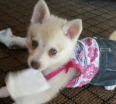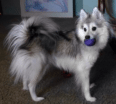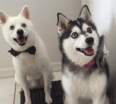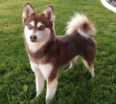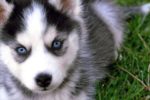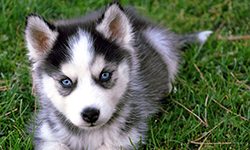Miniature Siberian Husky Dog Breed Information
It’s impossible to deny the beauty of a Siberian Husky. They are instantly recognizable and simply stunning. But, they are large breed with an independent attitude. Though they are extremely intelligent and wonderful family pets, they can be challenging for a first-time owner. If you are set on adding a Siberian Husky to your family but are worried about the size, consider a Miniature Siberian Husky! The Mini Siberian Husky is genetically identical to the standard Siberian Husky, just pint-sized!
Appearance
With their unmistakable facial features and signature coat, Miniature Huskies (sometimes referred to as a Teacup Husky), are a distinctly beautiful breed. They look exactly like a standard Siberian Husky, just smaller! Their coats can come in an array of combinations like black and white, red and white, or even pure white.
One distinct feature of Miniature Huskies is their eyes. They are typically almond shaped and can range in color – from two bright blue eyes, to two brown eyes, to one blue and one brown eye, or even brown and blue in the same eye (known as parti-eye).
Their ears stand in an erect triangular shape with rounded tips. Mini Huskies noses can be black, a liver color, or even flesh colored. Some Miniature Huskies can have a pink-streaked “snow nose” that gets more pale in the winter.
Origin
Miniature Huskies originated in the 1990’s. They were first bred by Bree Normandin. Her goal was to breed a smaller version of the standard Siberian Husky. So, she selectively bred Siberian Huskies that were remarkably small. This is the same practice used to breed Mini Siberian Huskies today.
Mini Huskies are derived from the standard Siberian Husky. The Siberian Husky is thought to have originated from a tribe of Siberian nomads known as the Chukchi. Though their breed history isn’t well-known, DNA tests have confirmed that they are amongst one of the oldest dog breeds. The Chukchi used Siberian Huskies for fast transportation as well as family dogs. They frequently slept with the children, who used them as warm beds!
Siberian Huskies were brought to Alaska in 1908. They were used as sled dogs during the gold rush as well as the All-Alaska Sweepstakes, a 408-milie dogsled race.
Recognized Breed – Pedigree
Miniature Huskies are not recognized by the AKC (American Kennel Club) since they are genetically identical to the Siberian Husky, just smaller in size.
The standard Siberian Husky was recognized by the AKC in 1930.
Temperament / Behavior
Siberian Huskies are naturally intelligent, curious breeds. Miniature Huskies are no different. They have very high energy levels and require a lot of physical and mental exercise. If they become bored, they can become destructive and begin chewing or digging. They can also take up constant barking.
Mini Huskies can also suffer from separation anxiety when left alone for too long. They do exceptionally well in a multi-dog household, as that helps with their bored and anxious tendencies. They are not known as an aggressive breed and generally get along with everyone – from children to strangers.
Miniature Huskies are extremely intelligent, but sometimes they use that intelligence for less than pleasant behavior. They also are not too keen on pleasing their owners. Mini Huskies are very difficult to train and will do best in a household that knows the breed or that is experienced in dog training.
One of their infamous traits is their reputation as an escape artist. They seem to be able to escape from any situation, whether that be a crate or a yard. They love to wander and will do so any chance they get.
Another one of a Mini Husky’s notorious traits is their howl. Miniature Huskies aren’t prone to barking so much as they are prone to howling. Some owners call it “talking”.
Miniature Huskies are an affectionate breed, but they are not known to be overly affectionate and will not constantly bother you for attention.
Physical Characteristics
The Mini Siberian Husky has a very thick, double coat that helps protect them from harsh weather. It is made up of a dense undercoat and a longer topcoat with straight, short hair. Due to the thickness of their coat, regular grooming and brushing is necessary to control shedding.
Miniature Siberian Huskies have the same colors and patterns as the standard Siberian Husky. They are most commonly black and white or red and white. They could also have grey, copper, or all white. Most Mini Huskies have “masks”, spectacles, or other distinct facial markings.
A Miniature Husky normally weights around 35 pounds, but it depends on the breeding. They stand between 12 and 16 inches in height.
Exercise Requirements
The Mini Siberian Husky is a very energetic breed. This is a breed that requires quite a bit of daily exercise. They will do best in a home with a fenced in yard. However, don’t leave a Mini Husky alone in the yard because of their notoriety as escape artists.
A solid 30-60 minutes of daily exercise will keep your Mini Husky from becoming bored and destructive. They will make great jogging partners, but they should not be exercised in hot weather due to their thick coats.
Health Concerns
Because Miniature Huskies are genetically the same as standard Siberian Huskies, they have the same health concerns as them. The most common health problems among this breed are genetic ones such as glaucoma, progressive retinol atrophy, and laryngeal paralysis. Luckily, due to its size, the Mini Husky has a low risk for developing hip dysplasia.
Miniature Siberian Huskies tend to live between 12 and 14 years.
Difference between a Mini Husky and an Alaskan Klee Kai
Though the Mini Husky and the Alaskan Klee Kai look and act very similar, they are in fact, two separate breeds. The Alaskan Klee Kai is a modern breed that was developed around the 1970’s. They didn’t become popular until around the 1980’s. The Klee Kai features traits from the Alaskan Husky and the Siberian Husky as well as the American Eskimo dog and the Schipperke.
Both the Alaskan Klee Kai and the Mini Husky were derived from existing dog breeds. They are members of the Spitz group and come from the same genetic background. They do share similar physical characteristics like their curved tails, double-layered thick coats, and pointed ears.
The Klee Kai and Miniature Husky are both thick-coated dogs that love the cold weather. At first glance, these two breeds can look very similar and it could be difficult to tell the difference, but their real differences lay in their personality and temperaments.
Being a smaller version of the Siberian Husky, the Mini Husky was bred as a working dog. They were bred to run, hunt, and pull sleds. They are a high energy, intelligent dog. They get bored quite easily and have a strong desire to hunt and chase. The Miniature Husky is a lively, outgoing, and friendly breed. They tend to get along with everyone – strangers included.
The Alaskan Klee Kai, on the other hand, was bred solely as a companion dog. Though they are intelligent and lively, they are not as energetic or one-track-minded as a Mini Husky. Klee Kai’s also tend to be more reserved around strangers and will bond very closely with their family. They do make excellent watchdogs and guard dogs, often alerting their family of any incoming strangers.
In terms of care and exercise, the Alaskan Klee Kai is not as high strung or challenging as a Mini Husky. While they certainly need proper exercise and mental stimulation, they were ultimately bred to be companion dogs rather than working dogs.
Alaskan Klee Kai’s, like Mini Huskies, are not recognized by the AKC yet. They are, however, recognized by the United Kennel Club and the American Rare Breed Association.
A Mini Siberian Husky is a wonderful option for those looking for all the qualities of a Siberian Husky in a smaller size!

